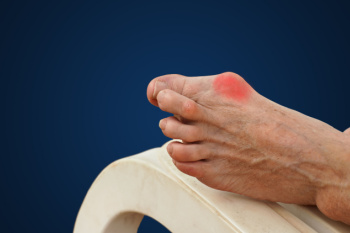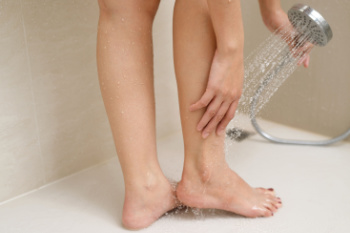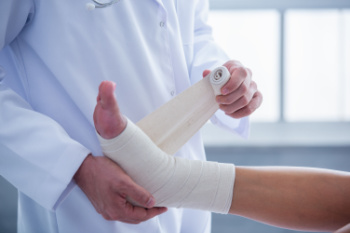
Claw toe is a deformity where the toes curl into a claw-like shape due to an imbalance in the muscles and tendons responsible for straightening the toes. The condition often causes the toes to bend upward at the joint closest to the foot and then sharply downward at the middle and third joints, leading to discomfort and the formation of painful calluses. Common causes include nerve damage, foot or ankle trauma, and conditions like diabetes or arthritis. If left untreated, claw toe can worsen over time, making early intervention important. A podiatrist can help manage claw toe by recommending non-invasive treatments such as custom orthotics, toe exercises, and footwear adjustments that provide more room for the toes. In more severe cases, surgery might be necessary to correct the deformity. If you notice a deformity in your toes, it is suggested that you schedule an appointment with a podiatrist for an evaluation and treatment options.
Toe pain can disrupt your daily activities. If you have any concerns, contact Brian Shwer, DPM of Southaven Foot Clinic. Our doctor can provide the care you need to keep you pain-free and on your feet.
What Causes Toe Pain?
Most severe toe pain is caused due to a sports injury, trauma from dropping something heavy on the toe, or bumping into something rigid. Other problems can develop over time for various reasons.
Toe pain can be caused by one or more ailments. The most common include:
When to See a Podiatrist
Diagnosis
In many cases the cause of toe pain is obvious, but in others, a podiatrist may want to use more advanced methods to determine the problem. These can range from simple visual inspections and sensation tests to X-rays and MRI scans. Prior medical history, family medical history, and any recent physical traumatic events will all be taken into consideration for a proper diagnosis.
Treatment
Treatments for toe pain and injuries vary and may include shoe inserts, padding, taping, medicines, injections, and in some cases, surgery. If you believe that you have broken a toe, please see a podiatrist as soon as possible.
If you have any questions please feel free to contact our office located in Southaven, MS . We offer the newest diagnostic tools and technology to treat your foot and ankle needs.

Diabetes is a chronic condition that affects the body's ability to regulate blood sugar levels, often leading to complications in the feet. High blood sugar can damage blood vessels and nerves, reducing circulation and sensation in the feet. This makes individuals with diabetes more susceptible to foot injuries and infections, as they may not feel wounds or pressure sores developing. If not properly treated, even minor foot injuries can lead to serious complications, such as ulcers, infections, or in severe cases, amputation. Proper diabetic foot care includes regular inspection of the feet for cuts, blisters, or sores, keeping the feet clean and dry, and wearing properly fitted shoes to avoid friction. Preventive measures like controlling blood sugar levels, regular foot check-ups with a podiatrist, and proper foot hygiene are imperative to avoiding serious complications and maintaining overall foot health. If you have diabetes and notice a foot wound, it is essential to see a podiatrist promptly to prevent an infection.
Diabetic foot care is important in preventing foot ailments such as ulcers. If you are suffering from diabetes or have any other concerns about your feet, contact Brian Shwer, DPM from Southaven Foot Clinic. Our doctor can provide the care you need to keep you pain-free and on your feet.
Diabetic Foot Care
Diabetes affects millions of people every year. The condition can damage blood vessels in many parts of the body, especially the feet. Because of this, taking care of your feet is essential if you have diabetes, and having a podiatrist help monitor your foot health is highly recommended.
The Importance of Caring for Your Feet
Patients with diabetes should have their doctor monitor their blood levels, as blood sugar levels play such a huge role in diabetic care. Monitoring these levels on a regular basis is highly advised.
It is always best to inform your healthcare professional of any concerns you may have regarding your feet, especially for diabetic patients. Early treatment and routine foot examinations are keys to maintaining proper health, especially because severe complications can arise if proper treatment is not applied.
If you have any questions please feel free to contact our office located in Southaven, MS . We offer the newest diagnostic and treatment technologies for all your foot and ankle needs.

Football players are particularly prone to ankle and foot injuries due to the sport’s high-impact nature and frequent lateral movements. Common injuries include sprains, where ligaments are stretched or torn, often from sudden changes in direction or contact. Fractures, such as those of the metatarsals or the ankle bones, occur from direct impacts or severe twists. Tendon injuries, like Achilles tendinitis, also pose a risk due to repetitive strain. Symptoms of these injuries typically include pain, swelling, and difficulty moving the affected area. Prevention strategies include wearing appropriate footwear with good support, incorporating strengthening exercises into training, and practicing proper techniques to reduce the risk of injury. If you have endured a foot or ankle injury while playing football, it is suggested that you visit a podiatrist for treatment, and offer you effective injury prevention techniques.
Sports related foot and ankle injuries require proper treatment before players can go back to their regular routines. For more information, contact Brian Shwer, DPM of Southaven Foot Clinic. Our doctor can provide the care you need to keep you pain-free and on your feet.
Sports Related Foot and Ankle Injuries
Foot and ankle injuries are a common occurrence when it comes to athletes of any sport. While many athletes dismiss the initial aches and pains, the truth is that ignoring potential foot and ankle injuries can lead to serious problems. As athletes continue to place pressure and strain the area further, a mild injury can turn into something as serious as a rupture and may lead to a permanent disability. There are many factors that contribute to sports related foot and ankle injuries, which include failure to warm up properly, not providing support or wearing bad footwear. Common injuries and conditions athletes face, including:
Sports related injuries are commonly treated using the RICE method. This includes rest, applying ice to the injured area, compression and elevating the ankle. More serious sprains and injuries may require surgery, which could include arthroscopic and reconstructive surgery. Rehabilitation and therapy may also be required in order to get any recovering athlete to become fully functional again. Any unusual aches and pains an athlete sustains must be evaluated by a licensed, reputable medical professional.
If you have any questions please feel free to contact our office located in Southaven, MS . We offer the newest diagnostic and treatment technologies for all your foot and ankle needs.
 A biomechanical assessment of the foot and ankle is a detailed evaluation conducted to understand the movement patterns and structural alignment of these areas. This assessment involves examining how the foot and ankle move during various activities, such as walking or running and identifying any abnormalities or dysfunctions. The primary purpose of a biomechanical assessment is to diagnose issues that may cause pain, discomfort, or impaired function. Common conditions identified through this process can include flat feet, overpronation, supination, and alignment issues affecting the knees, hips, and lower back. The assessment typically includes visual and physical examinations, gait analysis, and sometimes advanced imaging techniques. Conducting a biomechanical assessment is important for developing personalized treatment plans. It helps in prescribing appropriate orthotics, footwear, and exercises to correct identified problems. This evaluation is essential for athletes, individuals with chronic pain, and those recovering from injuries. If you have chronic foot or ankle pain, it is suggested that you visit a podiatrist for a biomechanical assessment and treatment based on results.
A biomechanical assessment of the foot and ankle is a detailed evaluation conducted to understand the movement patterns and structural alignment of these areas. This assessment involves examining how the foot and ankle move during various activities, such as walking or running and identifying any abnormalities or dysfunctions. The primary purpose of a biomechanical assessment is to diagnose issues that may cause pain, discomfort, or impaired function. Common conditions identified through this process can include flat feet, overpronation, supination, and alignment issues affecting the knees, hips, and lower back. The assessment typically includes visual and physical examinations, gait analysis, and sometimes advanced imaging techniques. Conducting a biomechanical assessment is important for developing personalized treatment plans. It helps in prescribing appropriate orthotics, footwear, and exercises to correct identified problems. This evaluation is essential for athletes, individuals with chronic pain, and those recovering from injuries. If you have chronic foot or ankle pain, it is suggested that you visit a podiatrist for a biomechanical assessment and treatment based on results.
If you have any concerns about your feet, contact Brian Shwer, DPM from Southaven Foot Clinic. Our doctor can provide the care you need to keep you pain-free and on your feet.
Biomechanics in Podiatry
Podiatric biomechanics is a particular sector of specialty podiatry with licensed practitioners who are trained to diagnose and treat conditions affecting the foot, ankle and lower leg. Biomechanics deals with the forces that act against the body, causing an interference with the biological structures. It focuses on the movement of the ankle, the foot and the forces that interact with them.
A History of Biomechanics
Modern technological improvements are based on past theories and therapeutic processes that provide a better understanding of podiatric concepts for biomechanics. Computers can provide accurate information about the forces and patterns of the feet and lower legs.
Understanding biomechanics of the feet can help improve and eliminate pain, stopping further stress to the foot.
If you have any questions please feel free to contact our office located in Southaven, MS . We offer the newest diagnostic and treatment technologies for all your foot and ankle needs.

A bunion is a bony bump at the base of the big toe, causing it to lean toward the second toe. This deformity, consisting of bone and soft tissue, can result in significant discomfort. Bunions often develop from wearing tight or narrow shoes, particularly among women. Heredity also may play a part in bunion development. When lifestyle changes like wearing wider shoes and using protective pads do not alleviate the pain, bunion removal surgery, or a bunionectomy, may be necessary. This outpatient procedure can involve osteotomy to realign the toe or exostectomy to remove the bunion. Post-surgery, recovery typically takes six to eight weeks, with full recovery in four to six months. Patients initially wear a surgical boot or cast, and gradually transition to weight-bearing activities. Long-term success after bunion surgery hinges on proper footwear choices to prevent recurrence. If you are experiencing toe pain from a bunion, it is suggested that you schedule an appointment with a podiatrist for an exam, diagnosis, and treatment options.
If you are suffering from bunions, contact Brian Shwer, DPM of Southaven Foot Clinic. Our doctor can provide the care you need to keep you pain-free and on your feet.
What Is a Bunion?
A bunion is formed of swollen tissue or an enlargement of boney growth, usually located at the base joint of the toe that connects to the foot. The swelling occurs due to the bones in the big toe shifting inward, which impacts the other toes of the foot. This causes the area around the base of the big toe to become inflamed and painful.
Why Do Bunions Form?
Genetics – Susceptibility to bunions are often hereditary
Stress on the feet – Poorly fitted and uncomfortable footwear that places stress on feet, such as heels, can worsen existing bunions
How Are Bunions Diagnosed?
Doctors often perform two tests – blood tests and x-rays – when trying to diagnose bunions, especially in the early stages of development. Blood tests help determine if the foot pain is being caused by something else, such as arthritis, while x-rays provide a clear picture of your bone structure to your doctor.
How Are Bunions Treated?
If you have any questions, please feel free to contact our office located in Southaven, MS . We offer the newest diagnostic and treatment technologies for all your foot care needs.

Foot pain can originate from various areas, each indicating different potential causes. Generalized toe pain may suggest conditions like arthritis or improper footwear causing pressure. Pain in the big toe often points to gout or bunions, while discomfort in the ball of the foot may be due to metatarsalgia from high-impact activities or wearing high heels. Heel pain, commonly associated with plantar fasciitis, occurs due to inflammation of the ligament connecting the heel bone to the toes. Arch pain may signal conditions, such as flat feet or plantar fasciitis, where the arch support structure is strained. Identifying the precise location of foot pain helps determine appropriate treatments, such as rest, stretching exercises, or orthotic inserts. If you have any type of foot pain, it is suggested that you consult a podiatrist who can provide an accurate diagnosis and a tailored treatment plan.
Foot Pain
Foot pain can be extremely painful and debilitating. If you have a foot pain, consult with Brian Shwer, DPM from Southaven Foot Clinic. Our doctor will assess your condition and provide you with quality foot and ankle treatment.
Causes
Foot pain is a very broad condition that could be caused by one or more ailments. The most common include:
Diagnosis
To figure out the cause of foot pain, podiatrists utilize several different methods. This can range from simple visual inspections and sensation tests to X-rays and MRI scans. Prior medical history, family medical history, and any recent physical traumatic events will all be taken into consideration for a proper diagnosis.
Treatment
Treatment depends upon the cause of the foot pain. Whether it is resting, staying off the foot, or having surgery; podiatrists have a number of treatment options available for foot pain.
If you have any questions, please feel free to contact our office located in Southaven, MS . We offer the newest diagnostic and treatment technologies for all your foot care needs.

Maintaining proper foot hygiene is essential for overall health and comfort. Everyday foot care can begin with regularly washing feet with soap and water. This can help to remove dirt and bacteria, reducing the risk of infections. Thoroughly drying feet, especially between the toes, prevents fungal growth. Wearing clean, moisture-wicking socks can keep feet dry and comfortable throughout the day. Properly fitting shoes that provide adequate support can help to prevent blisters and calluses. Regularly trimming toenails straight across reduces the risk of ingrown nails. Moisturizing feet daily keeps skin supple and prevents cracks. Checking feet for any cuts, blisters, or changes in appearance can catch potential issues early. Foot conditions may develop from a lack of proper foot care. If this applies to you, it is suggested that you consult a podiatrist who can treat any foot ailment, and guide you on effective foot care routines.
Everyday foot care is very important to prevent infection and other foot ailments. If you need your feet checked, contact Brian Shwer, DPM from Southaven Foot Clinic. Our doctor can provide the care you need to keep you pain-free and on your feet.
Everyday Foot Care
Often, people take care of their bodies, face and hair more so than they do for their feet. But the feet are a very important aspect of our bodies, and one that we should pay more attention to. Without our feet, we would not be able to perform most daily tasks.
It is best to check your feet regularly to make sure there are no new bruises or cuts that you may not have noticed before. For dry feet, moisturizer can easily be a remedy and can be applied as often as necessary to the affected areas. Wearing shoes that fit well can also help you maintain good foot health, as well as making it easier to walk and do daily activities without the stress or pain of ill-fitting shoes, high heels, or even flip flops. Wearing clean socks with closed shoes is important to ensure that sweat and bacteria do not accumulate within the shoe. Clean socks help to prevent Athlete’s foot, fungi problems, bad odors, and can absorb sweat.
If you have any questions please feel free to contact our office located in Southaven, MS . We offer the newest diagnostic and treatment technologies for all your foot and ankle needs.
 A broken foot or toe involves a fracture in the bones of the foot or toes, often caused by trauma such as falls, sports injuries, or heavy objects dropping on the foot. Symptoms can include immediate pain, swelling, bruising, and difficulty while walking or bearing weight. First aid for a broken foot or toe starts with immobilization to prevent further injury. Keep the foot elevated to reduce swelling, avoid putting weight on the injured foot, and use crutches, if necessary. Pain relievers can help manage pain and inflammation. Proper treatment is important as complications from untreated fractures can include chronic pain, improper healing, and arthritis. In severe cases, surgery might be required to realign the bones. If you have broken your foot or a toe, it is suggested that you visit a podiatrist sooner, rather than later. This medical professional can provide appropriate treatment and rehabilitation plans to ensure proper healing.
A broken foot or toe involves a fracture in the bones of the foot or toes, often caused by trauma such as falls, sports injuries, or heavy objects dropping on the foot. Symptoms can include immediate pain, swelling, bruising, and difficulty while walking or bearing weight. First aid for a broken foot or toe starts with immobilization to prevent further injury. Keep the foot elevated to reduce swelling, avoid putting weight on the injured foot, and use crutches, if necessary. Pain relievers can help manage pain and inflammation. Proper treatment is important as complications from untreated fractures can include chronic pain, improper healing, and arthritis. In severe cases, surgery might be required to realign the bones. If you have broken your foot or a toe, it is suggested that you visit a podiatrist sooner, rather than later. This medical professional can provide appropriate treatment and rehabilitation plans to ensure proper healing.
A broken foot requires immediate medical attention and treatment. If you need your feet checked, contact Brian Shwer, DPM from Southaven Foot Clinic. Our doctor can provide the care you need to keep you pain-free and on your feet.
Broken Foot Causes, Symptoms, and Treatment
A broken foot is caused by one of the bones in the foot typically breaking when bended, crushed, or stretched beyond its natural capabilities. Usually the location of the fracture indicates how the break occurred, whether it was through an object, fall, or any other type of injury.
Common Symptoms of Broken Feet:
Those that suspect they have a broken foot shoot seek urgent medical attention where a medical professional could diagnose the severity.
Treatment for broken bones varies depending on the cause, severity and location. Some will require the use of splints, casts or crutches while others could even involve surgery to repair the broken bones. Personal care includes the use of ice and keeping the foot stabilized and elevated.
If you have any questions please feel free to contact our office located in Southaven, MS . We offer the newest diagnostic and treatment technologies for all your foot and ankle needs.